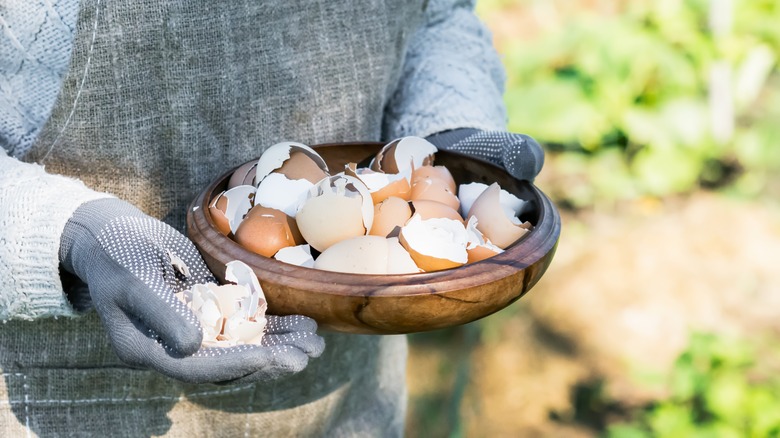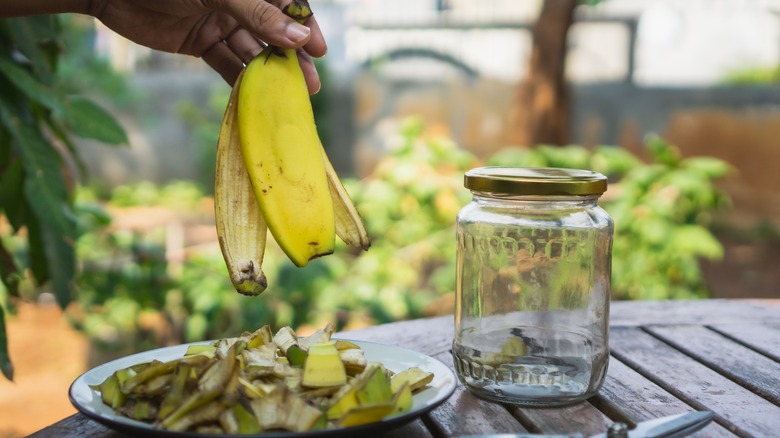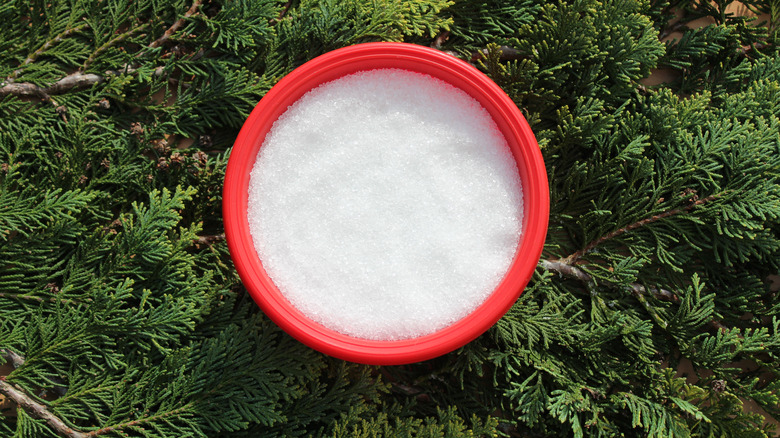The 8 Best Ways To Fertilize Avocado Trees (& 4 To Avoid)
There's nothing more satisfying than harvesting the literal fruits of your labor, and if you've grown an avocado tree from a pit, then there's no prouder plant parent than you. As you've probably realized, though, keeping avocado trees happy enough to produce fruits takes more than a little potting soil and water. If you get your avocado tree's care requirements right you'll be rewarded with never needing to pay extra for guac again. But if you get it wrong, your tree could suffer from nutrient imbalances, root burn, or even plant death.
If you're starting to feel anxious because you suddenly realized you fell asleep during the plant section of biology class, don't worry; anyone can grow avocado trees once they understand the difference between what gives them the nutrients they need and what's overkill. It's not complicated, especially when we're here to help. Here are ways you can keep your avocado tree happy and healthy, plus a few methods to steer clear of and why.
Use urea for nitrogen
Okay, let's just get this out of the way: Yes, sometimes urea comes from pee. But before you pop a squat by your avocado tree, it's only one component of urine. When the body breaks down a protein into amino acids, ammonia is created. The liver converts the ammonia into a safer compound, urea, and the body excretes it. Urea makes a powerful fertilizer because it's 46% nitrogen, a critical macronutrient that gives plants the ability to make chlorophyll, proteins, amino acids, hormones and helps increase crop yields.
First, get a soil test done to ensure you're not adding too much nitrogen, as too much can cause root burn. Once you've gotten your results back showing there's a nitrogen deficiency, head to a feed or farm supply store where you can usually find urea sold in pellet form. Till the soil around your tree and sprinkle in the pellets during its growing season to help replenish the nitrogen it's losing to produce fruit. The amount of urea to add depends on a few factors, but generally speaking, you'll want to use enough that it equates to adding 0.1 pounds of nitrogen per tree for every year it matures. That will look something like half of a cup of urea for a growing tree.
Use kelp for potassium
Avocado trees typically won't produce fruit until the third year. During that third year, your tree uses a ton of energy to make the avocados, and that energy has to come from somewhere. Researchers found that harvested avocado crops have double the amount of potassium (K) than nitrogen (N), and now recommend growers to give their tree a potassium boost after its third birthday. And that's where kelp comes into play, containing anywhere from 4 – 13% potassium. This is enough to help but not so much that you risk overfertilizing.
Kelp is an amazing soil additive chock full of minerals and nutrients. Farmers have used it for hundreds of years to improve soil conditions, and a 2016 Scientific Reports study found that adding kelp waste extract into pakchoi soil resulted in "stimulated seed germination, enhanced plant growth, root development, leaf quality and yield, improved resistance to biotic and abiotic stresses, as well as increased post harvest shelf life." If it can do that for pakchoi, imagine what it can do for your avocado plant.
There are two ways to fertilize with kelp: fresh or powder. Avocado leaves have a waxy coating that makes some liquid fertilizers useless. However, researchers found that potassium-based sprays were an exception for Haas avocados. For fresh: rinse the kelp to remove excess salts, then submerse in a bucket and let sit for a few weeks. Strain into a sprayer and mist your tree 2-3 times during its growing season. For powder: add half a teaspoon to a gallon of water and apply as a spray or pour into the soil.
Use fish emulsion for a well-balanced fertilizer
Here's a super-quick science lesson: Most plants need three major nutrients — nitrogen (N), potassium (K), and phosphorous (P). Avocado trees, in particular, are heavy consumers of nitrogen and potassium, so finding a fertilizer that can give you a well-balanced dose of both is key. Fish emulsion is one option with an average ratio of 5-1-1 NPK. Plus, it's fast-acting and has proteins that feed soil microorganisms, which improve the health and quality of the soil your tree's roots derive their nutrients from.
That said, we need to mention some caveats about using it. Fish emulsion is created by adding sulphuric acid to the leftover oils and liquids from processed fish remains. So the first issue to consider is the smell, which is both fishy and sulfurous. Most gardeners opt to use it only for plants that live outdoors. But that brings the next problem — wildlife. Some gardeners report that raccoons end up digging in their gardens searching for the tasty fish they smell, so you might need to protect your trees from critters. That said, there are significant benefits to fish emulsion that could outweigh these two setbacks if you're up to the challenge. To use fish emulsion fertilizer, add six tablespoons into a gallon of water and use it to water the soil.
Use plant meals as a vegan-friendly fertilizer
If you'd prefer to use plant-based fertilizers for your avocado tree, you're in luck, as there are lots of options that will give it the nutrients it needs. Besides the aforementioned kelp, corn gluten meal (CGM) is a protein-rich fertilizer that's 10% nitrogen, making it popular for gardeners with seriously nutrient-deficient soils. However, be extremely careful if you use this, as too much nitrogen can cause root burn to your tree. Cottonseed meal is also a popular nitrogen-rich fertilizer, and it's better balanced than corn gluten meal, with 6-4-1.5 NPK to CGM's 9-0-0, respectively. Lastly, alfalfa meal has an NPK ratio of 5-1-2, making it not only a gentle, well-balanced option but it'll also add triacontanol to your soil, a natural fatty acid that has growth boosting properties. Luckily, it's super easy to find as rabbit food in any pet supply store.
If you want to use plant meal fertilizers, you'll need to source them carefully and make sure you buy from a supplier that guarantees the origin crops are pesticide-free. Cotton seeds, in particular, can keep pesticide residue on them during their processing into meal, eventually ending up in your soil. Most plant meal application rates are for large-scale farm operations, so you'll need to do a little math to determine how much soil you're fertilizing and determine the right ratio for your needs.
Use a little blood meal for nitrogen
Want to make your avocados feel a bit spooky? Then, add a little blood meal to their soil. Not only will you give them a good hit of one of their most essential nutrients, but you'll be able to casually mention to your friends that you've noticed your trees shake a little with excitement whenever you cut yourself preparing meals. Okay, so the likelihood of vampiric avocado trees probably won't happen, but they'll still do well with a few sprinkles of blood meal fertilizer since it's one of the best options available for adding nitrogen naturally to your soil.
Blood meal is derived from slaughterhouse refuse and comes in the form of dark, reddish-brown pellets. Experts recommend applying it at a rate of 5-10 pounds per 100 square feet of soil, but opt for the more conservative side for your first application. Blood meal has a typical NPK ratio of 12-0-0, meaning it's all nitrogen, baby. On one hand, that's great for soil that's seriously lacking nutrients. On the other, too much nitrogen leads to an increased ammonia level in the soil, which can burn your tree's roots. So apply it sparingly and keep an eye out for signs of root burn.
Use bone meal for phosphorous, but only if your soil is acidic
Phosphorous is like the lesser-known member of a boy band group. Plants wouldn't be the same without it, but it's often left as an afterthought behind its more popular nutrient mates, nitrogen and potassium. But phosphorous deserves its spotlight, too, because it's the macronutrient that helps roots and fruits grow. While avocado trees don't need a lot of phosphorous, researchers have found that adding it to soils could help improve a tree's long-term crop yield. So, if your tree hasn't been giving you the quantity of avocado fruits you're expecting, drop a few tablespoons of bone meal into the soil. Bone meal not only gives your plant a little calcium boost (which helps strengthen plant cells), but it's chock-full of phosphorous, with an NPK ratio of 3-15-0. Plus, it's super cheap.
That said, phosphorous is a bit tricky to add to alkaline soils, which is why a soil test comes in handy since it'll tell you the pH level of your planting area. Researchers found that soils with a pH above 7.0 couldn't transfer phosphorous from bone meal to plant roots, so opt for another source like worm castings or compost. In the best-case scenario, the bone meal should be added to the soil before planting your trees and put directly into the dig site. Phosphorous isn't something that moves easily in soil, so it needs to be as close to where your tree's roots will be to work. The amount of bone meal you'll need depends on your soil's nutrient levels, but a general guide is to expect five to 10 pounds for every 100 square feet of soil.
Use eggshells and vinegar for calcium
Calcium is great because it gives your avocado tree a little more structure to its cell walls, helps keep the plant alive when stressed, and gives its roots a better defense against the bacteria that causes root rot. So, how can we give it a calcium boost? With a super-simple DIY combo: just add crushed eggshells to white vinegar. And if you're worried that the vinegar will mess with pH levels, don't worry; vinegar breaks down too fast to acidify soil.
Here's the thing: dry eggshells are chock-full of calcium, but it's a non-dissolvable form called calcium carbonate, making it near-impossible for a plant's roots to pull it from the soil. For the calcium to be accessible, the shells must either be crushed into a super-fine powder or converted into a soluble format. This is where vinegar comes in. Its weak acid creates a chemical reaction that converts the calcium to a water-soluble form. To make water-soluble calcium, break your eggshells into smaller pieces then cook them over a low heat for 45 minutes to make sure any membrane or organic material is gone (otherwise, it will spoil the fertilizer). Once your shells are dried, add them to a jar that's two-thirds full of vinegar. Cover the mouth with a breathable fabric, secure it with a rubber band, and let it sit somewhere cool and dark for a week. Once you stop seeing bubbles, your solution is ready to go (but if you still see bubbles after 10 days, add more roasted eggshells and wait). Strain the solution and then pour it close to your tree's roots.
Only use banana peels if you have high nitrogen levels
On the surface, banana peels seem like a great fertilizer. They're usually 7-8% potassium, one of the highest organic potassium options available. Plus, they quickly decompose right in the soil, making it an easy way to reduce your waste output. However, there is a catch. Banana peels have a major drawback to being in your soil, and that's that they need nitrogen to decompose. The peels will siphon nitrogen from the soil, competing with your avocado plant. While a big, established avocado tree wouldn't think twice about dealing with a tiny banana peel, a new or fledgling plant might stress itself by looking for resources that the peels are taking away.
However, there doesn't seem to be a consensus from the scientific community on whether or not banana peels are so nitrogen-siphoning that they're dangerous to use. Some researchers think their quick decay makes it a worthwhile trade-off, especially since they'll release valuable micronutrients in addition to potassium. Others, however, think they're not worth the hassle and are best left to the compost heap. Based on the evidence, it's probably okay to add banana peels if your soil already has high nitrogen levels that can handle both the peel decay and your tree's growth. However, if your soil is low on nitrogen, it's better to opt for a potassium-rich fertilizer that plays nicer with its neighbors, like kelp or seaweed extract.
Avoid weed and feed type fertilizers
Weed and feed fertilizers work by delivering herbicides and fertilizers to the soil. It sounds great; who doesn't love a product that makes their chore list shorter? However, these products are dangerous for fruiting or tropical trees since their root systems can absorb the herbicide chemicals. Plus, it's too hard to control the levels; how do you know whether this shake of weed and feed is 50/50 herbicide/fertilizer, or 30/70, or 100/0? It could lead to over- or under-fertilizing your trees. As we've discussed, over-fertilizing can seriously damage a plant's root system, but under-fertilization obviously isn't great either. Plus, the potential for giving your tree a shot of harsh weed-killing chemicals that seep through the roots and damage its fruits just doesn't make it worth the "convenience" factor (that is anything but).
If you want help to lighten the load of caring for your avocado trees, skip the weed and feed and opt for a well-balanced fertilizer like plant-based meals such as cottonseed, alfalfa, or kelp. If weeds are becoming a problem, opt for using game-changing ground covers or any of these weed removal hacks you'll wish you had tried sooner.
Avoid fresh manure
Manure has been used for hundreds of years because it enhances the soil's ability to retain water and improves its structure,making it easier for plant roots to spread. However, that does not mean it's a good fertilizer. Manure typically has some macronutrients, but it does not come with a guaranteed N-P-K levels the way packaged fertilizers mentioned above do, so there's no guarantee for what you're getting. Plus, fresh manure may contain harmful bacteria like E. coli that can contaminate avocado fruits and make you really sick.
While manure is a "no-no" for fertilizing your trees directly, it's important to remember that runoff may be an issue you'll have to deal with, especially if a neighbor uses manure without taking proper environmental precautions to ensure to doesn't seep into your waterways. Make sure that wherever you're planting your avocado trees is as far away from lawns or fields treated with manure as possible. If you want a balanced fertilizer that's safer for your trees and the environment, shoot for a plant-based option like alfalfa pellets or cottonseed meal.
Avoid epsom salt if you haven't done a soil test
Magnesium isn't among the "top three" macronutrients, but it's still important. Your avocado tree needs magnesium for chlorophyll production, and a tree with good magnesium levels will bear fruits that taste better and have a longer shelf life. Because of this, many people opt to fertilize their avocado trees with a common household ingredient that gives them a magnesium boost: Epsom salt. While it's true that Epsom salt is a good source of magnesium, the problem is in its application. Too often, gardeners add it without doing a soil test first and the consequences are disastrous. Too much magnesium in your avocado tree's soil can stop it from absorbing calcium. And since calcium is important for plant cell structure, it's hard to have a strong, healthy avocado tree with too much magnesium.
Only add Epsom salt if your soil test shows a serious magnesium deficiency in your garden. Also, be aware that adding it to sandy soils will result in leaching that pollutes groundwater, and it could amplify any pre-existing root rot. Can Epsom salt be a useful soil additive? Absolutely, but only when a magnesium intervention is necessary. Otherwise, it's just asking for trouble and will do more harm than good.
Avoid using coffee grounds to make soil more acidic
Avocado trees are sensitive plants, especially when they have to live in alkaline soil. If their soil has a pH higher than 7.0, their ability to take in iron and zinc is affected, and the tree suffers. Iron and zinc are critical metals used for plant growth functions and photosynthesis, so it's a big deal when your soil is getting in the way of your tree getting them. Some people will add coffee grounds to their soil to acidify it and make their avocado tree happy, but coffee grounds acidifying soil is a myth. In truth, coffee grounds have lots of beneficial qualities for soil, but they cannot consistently lower a soil's pH.
To ensure your tree has access to what it needs, first, you'll need to do a soil test to determine its pH level. If your soil is at a level that's below 7.0, then it's acidic (the lower the number, the more acidic the soil), and there's not much to do. If it's at 7.0, then it's neutral and could use a little adjustment. If it's above 7.0, then it's considered alkaline and will need acidifying ingredients added. Lime is a popular option, but there are other ways you can make your soil more acidic, such as using aluminum sulfate or elemental sulfur.












